The opening is an important aspect of any chess game. More often than not, whether a player wins or loses, the game is decided by how well they can play the opening.
Therefore, understanding the opening is very important for any chess player as the opening is the foundation of any chess game.
If the opening is weak, a player will struggle in the middlegame and the endgame.
Openings have to be played with the utmost attention to detail. The great chess player Rudolph Spielmann said, “Play the opening like a book, the middlegame like a magician, and the endgame like a machine.”
This quote means that the opening should be played with surgical precision to get an edge over your opponent or to have a perfect foundation going into the middle game.
There are numerous opening lines out there for both White and Black. While most players are well acquainted with the popular chess openings for White, openings like the Ruy Lopez, Queen’s Gambit, etc., chess openings for Black are not widespread, especially among beginners and intermediate players.
In this article, we will take you through ten of the best chess openings for Black.
1. Sicilian Defense
Are you tired of always having to play passive after white plays 1. e4 in the opening? If yes, then we strongly suggest you try playing the Sicilian Defense.
The Sicilian is the most popular defense, with the highest win rate against White’s e4 move. White players these days play 1. d4 to escape the deadly waters of the Sicilian.
The move that starts off the Sicilian by Black is the c5 response to White’s e4.
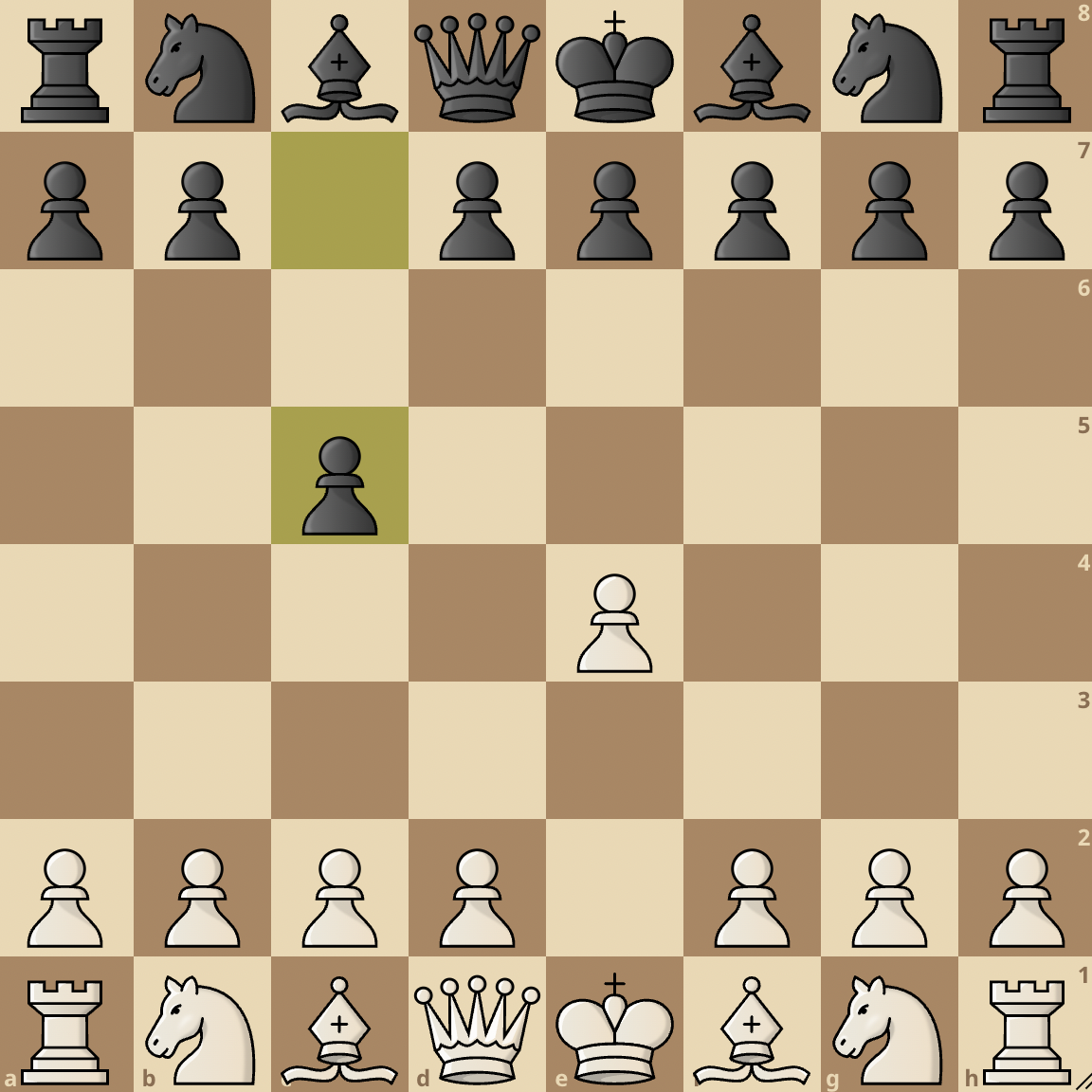
There are different lines and variations of the Sicilian Defense. They include the Open Sicilian, Closed Sicilian, Dragon Sicilian, and The Najdorf Sicilian, which was popularised by Grandmaster Miguel Najdorf and is a favorite of grandmasters like Maxime Vachier Lagrave and Magnus Carlsen.
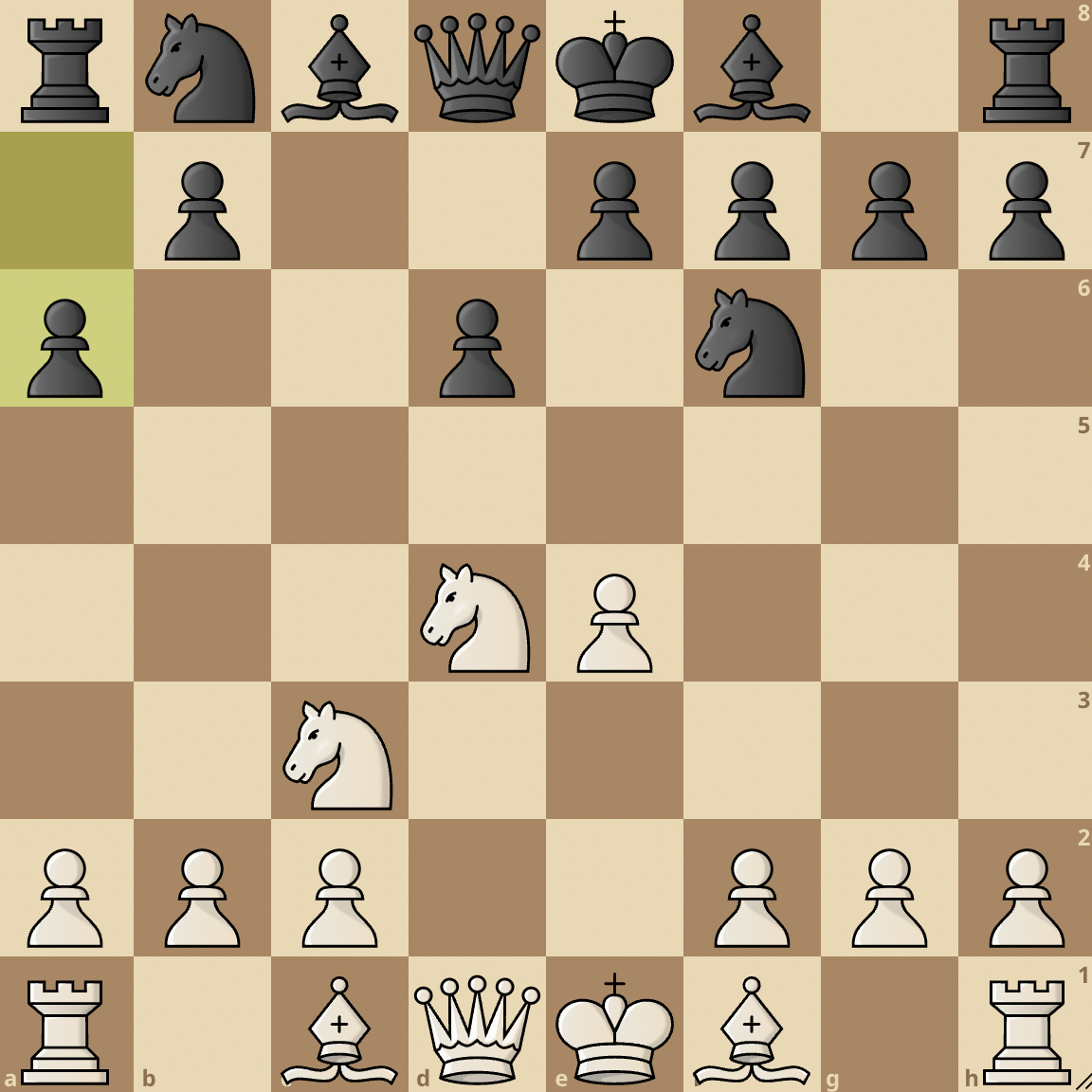
The Sicilian Defense is one of the best chess openings for Black as it promises an extremely sharp and fighting game.
Learn more in our detailed Sicilian Defense guide.
2. Scandinavian Defense
The Scandinavian Defense is a defense for Black that looks to immediately counter White’s e4 push and undermine the center control White has.
Also, the Scandinavian defense is the oldest recorded opening for Black in chess. It starts with the move d5 by Black in response to e4 by White.
Black looks to immediately challenge the center control White has by attacking the e4-pawn while opening lines for his c8 bishop to get into the game.
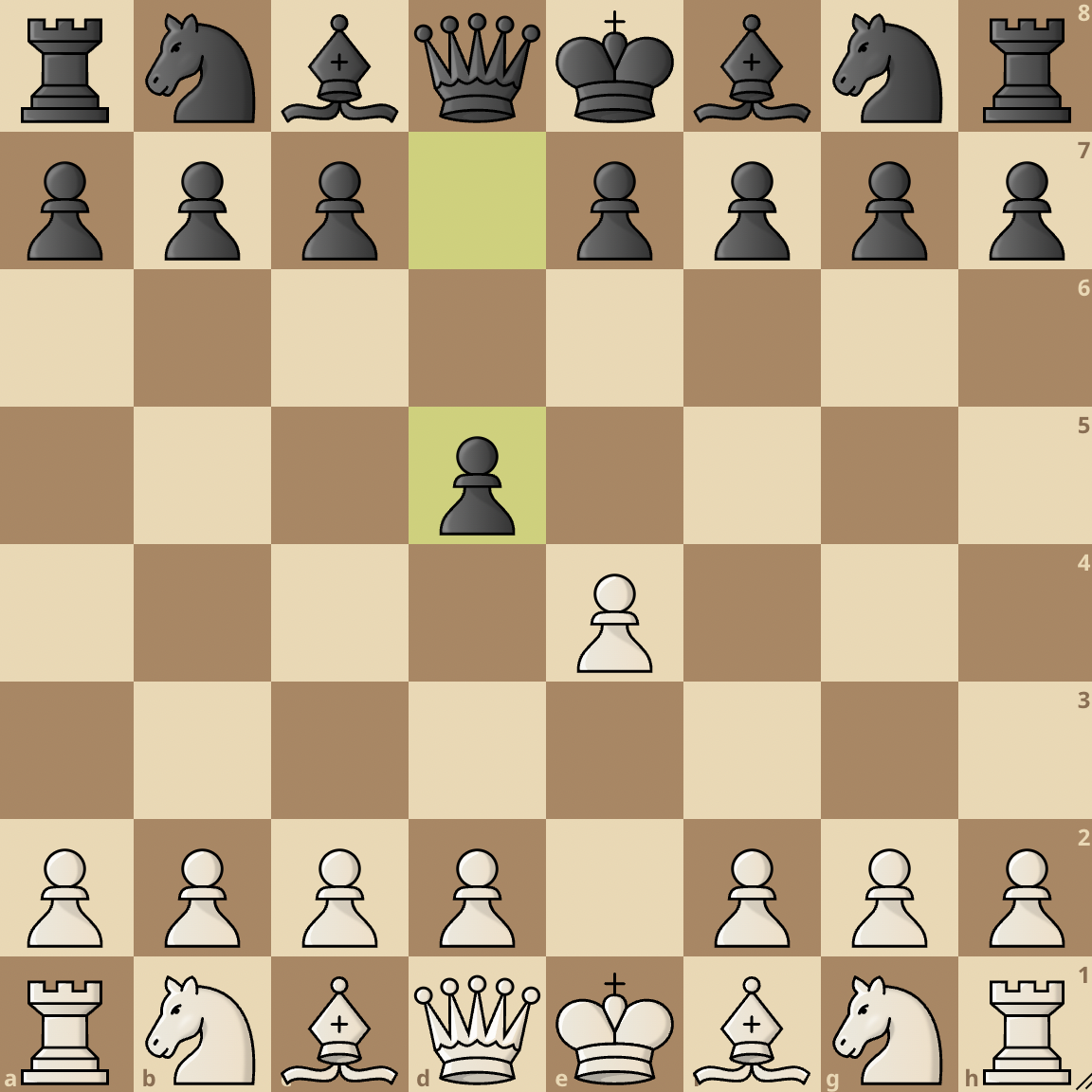
If you play this defense, more often than not, White will capture your pawn on d5 and then it depends on whether you want to play the main line, which is 2…Qxd5, or go for sharper lines like the Icelandic Gambit.
The Icelandic Gambit is an aggressive line of the Scandinavian Defense. Instead of taking the pawn on d5, Black looks to give up the material in exchange for developmental lead and a semi-open file for his queen.
The sequence of the Icelandic Gambit is: 1. e4 d5 2. exd5 Nf6 3. c4 e6
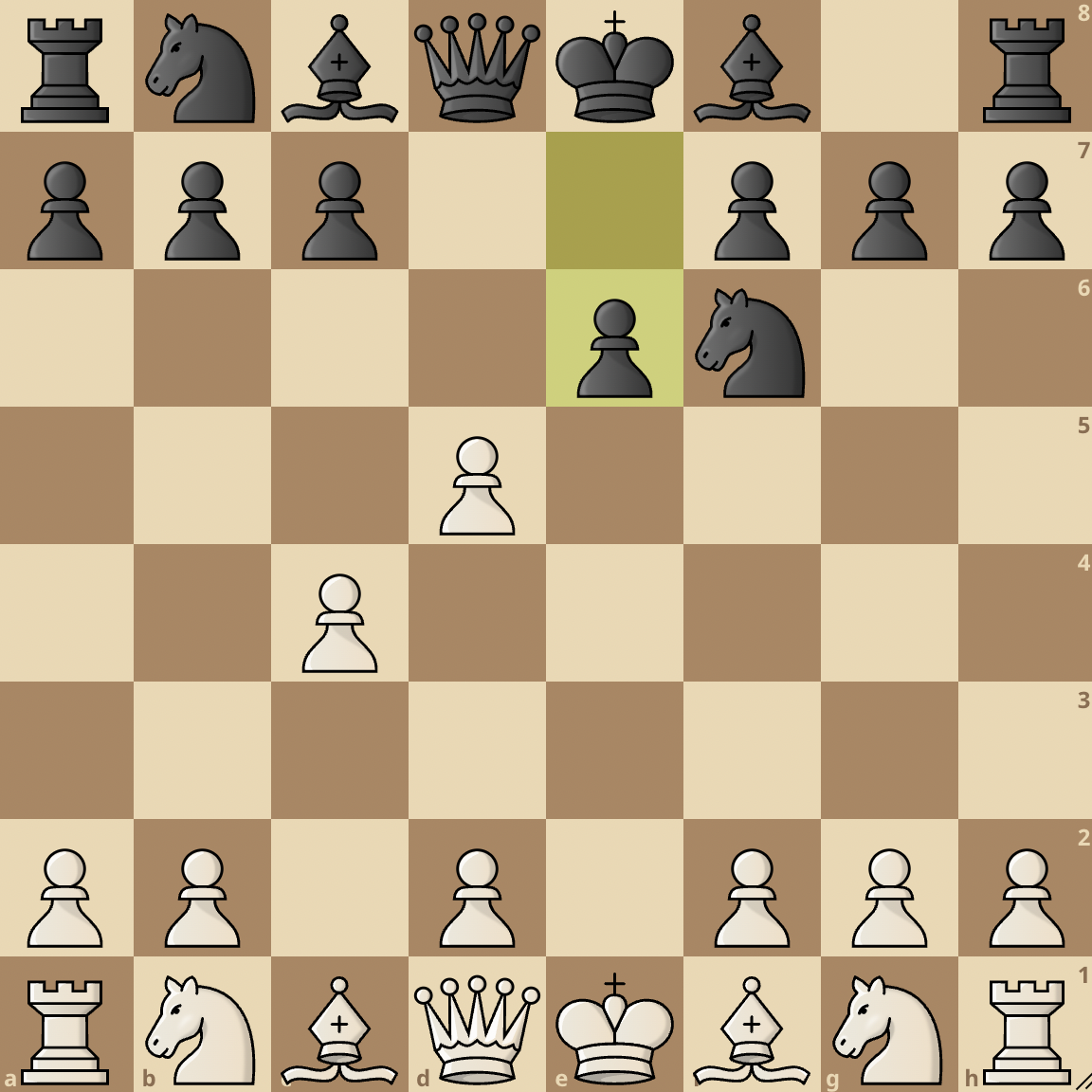
White has to be very careful when playing against the Icelandic Gambit as it gives Black a variety of attacking options.
If your opponent is not well-grounded in the lines of the Icelandic Gambit, you can easily gain a decisive advantage early on in the game
Learn more in our detailed Scandinavian Defense guide.
3. Caro-Kann
Are you a player that likes to play solid and positional chess? If yes, you should add the Caro-Kann to your opening repertoire.
The Caro-Kann derives its name from two 19th-century chess players, Horatio Caro and Marcus Kann.
Aside from having a cool name, the Caro-Kann is one of the best chess openings for Black that promises a substantial and positional advantage for Black against the King’s pawn opening (1. e4).
Although it’s similar to the Sicilian and French Defense, it is more solid and dynamic than either of the two chess openings for Black. It often leads to a better pawn structure for Black, thereby making the endgame easier for you to play.
Top players also love the Caro-Kann. It is a personal favorite of the chess prodigy grandmaster Alireza Firouzja. So, if you want to win like Alireza, play the Caro-Kann!
The Caro-Kann starts off with the moves: 1. e4 c6
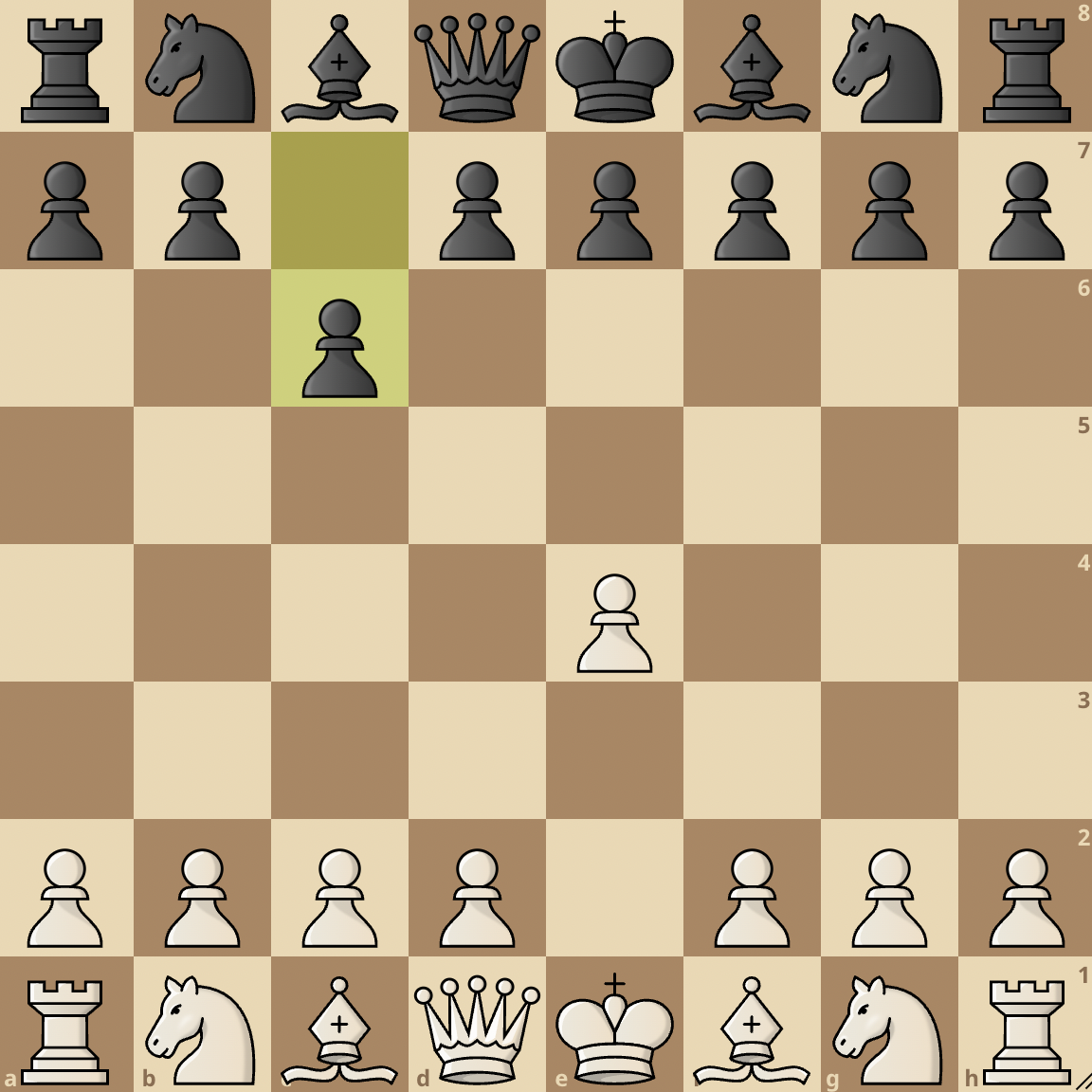
The main line of the Caro-Kann continues with:
2. d4 d5
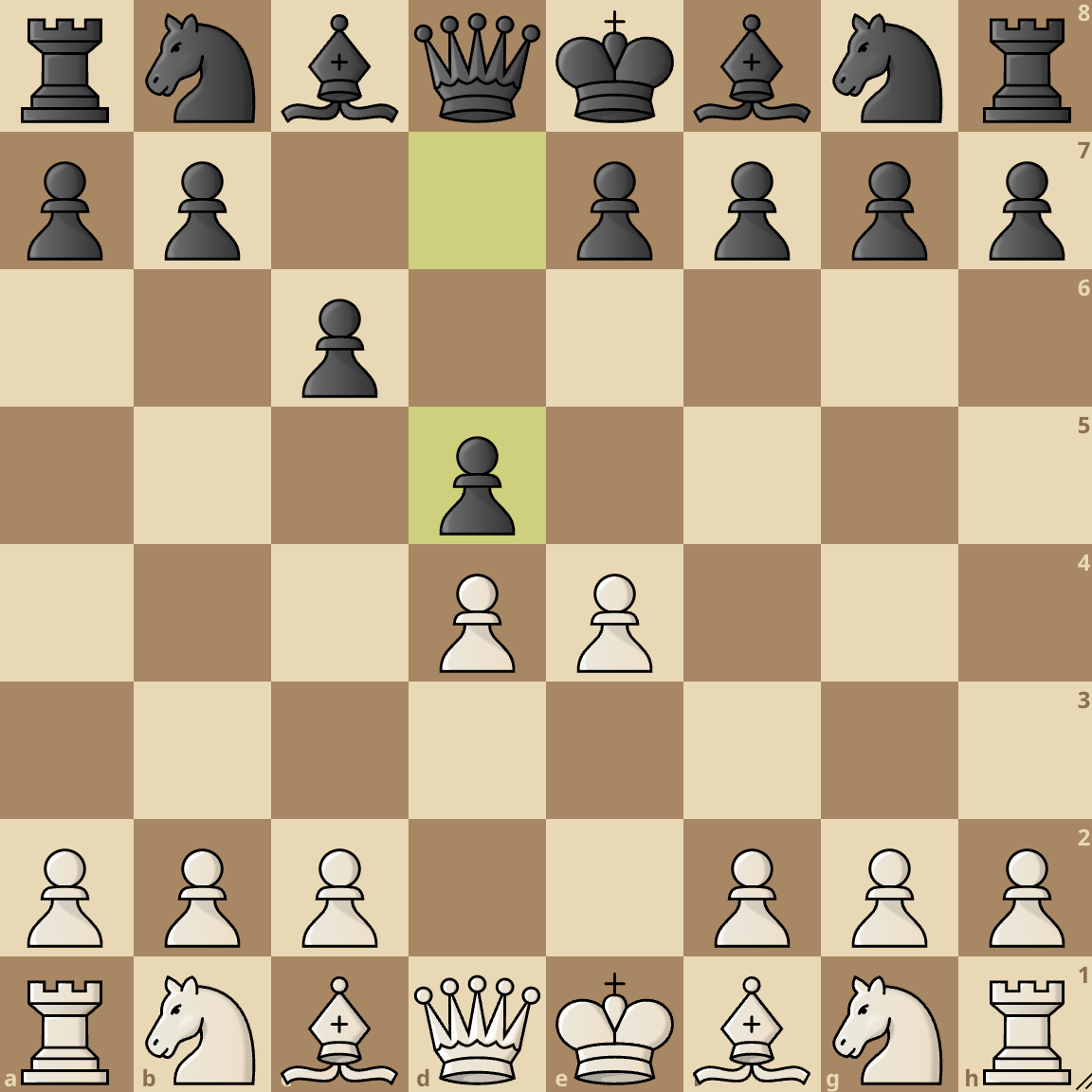
After 2. d4 d5, the most common moves are 3. Nc3 (Classical and Modern variations), 3. Nd2, 3. exd5 (Exchange Variation), and 3. e5 (Advance Variation).
The Caro-Kann is one of the chess openings for Black that every player needs to know.
Learn more in our detailed Caro-Kann Defense guide.
4. King’s Indian Defense
We’ve looked at three possible responses to White’s e4 move in the opening. What if your opponent freaks out knowing your extensive knowledge on how to counter e4 and instead plays d4?
Well, bad news for them because this opening is another strong weapon against White when they play 1. d4.
The King’s Indian Defense is a solid response to the d4 move by white. It’s a hypermodern opening, where Black deliberately allows White control of the center with its pawns, with the view to challenge it subsequently.
It arises after the moves: 1. d4 Nf6 2. c4 g6
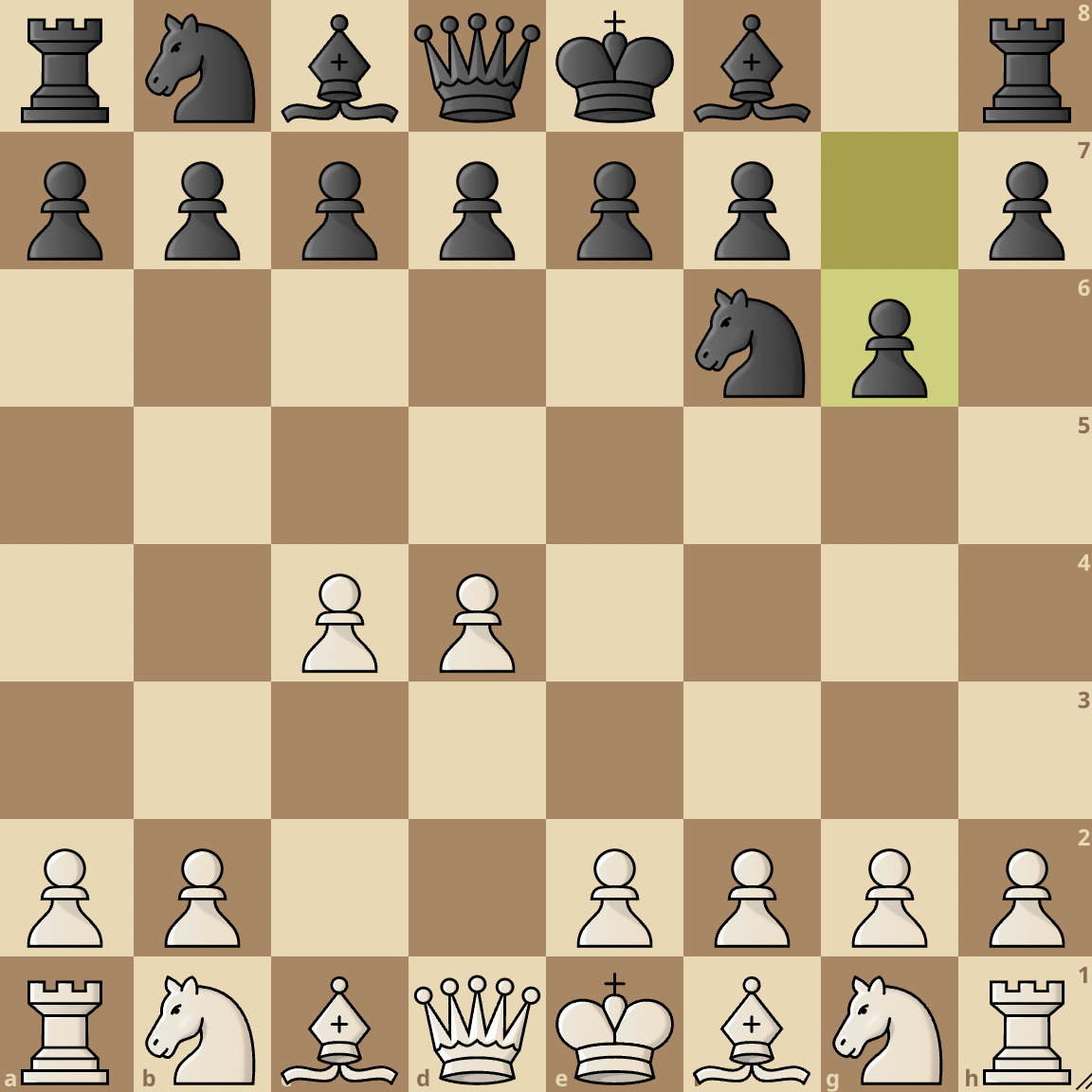
In the most critical lines of the King’s Indian, White creates a large pawn center with Nc3 followed by e4.
Black then tries to stake his control with …c5 or …e5. If White resolves the tension in the center with d5, Black follows with either b5 and queenside play or f5 and an eventual kingside attack.
Meanwhile, White will look to expand on the opposite wing. The resulting unbalanced positions promise sharp and active play for both sides.
Learn more in our detailed King’s Indian Defense guide.
5. Petrov Defense
The Petrov Defense (also known as the Petroff Defense or Russian Defense) is a chess opening for Black that begins with the moves 1. e4 e5 2. Nf3 Nf6.
This opening was named after Russian chess player Alexander Petrov, who analyzed this opening extensively in the 19th century.
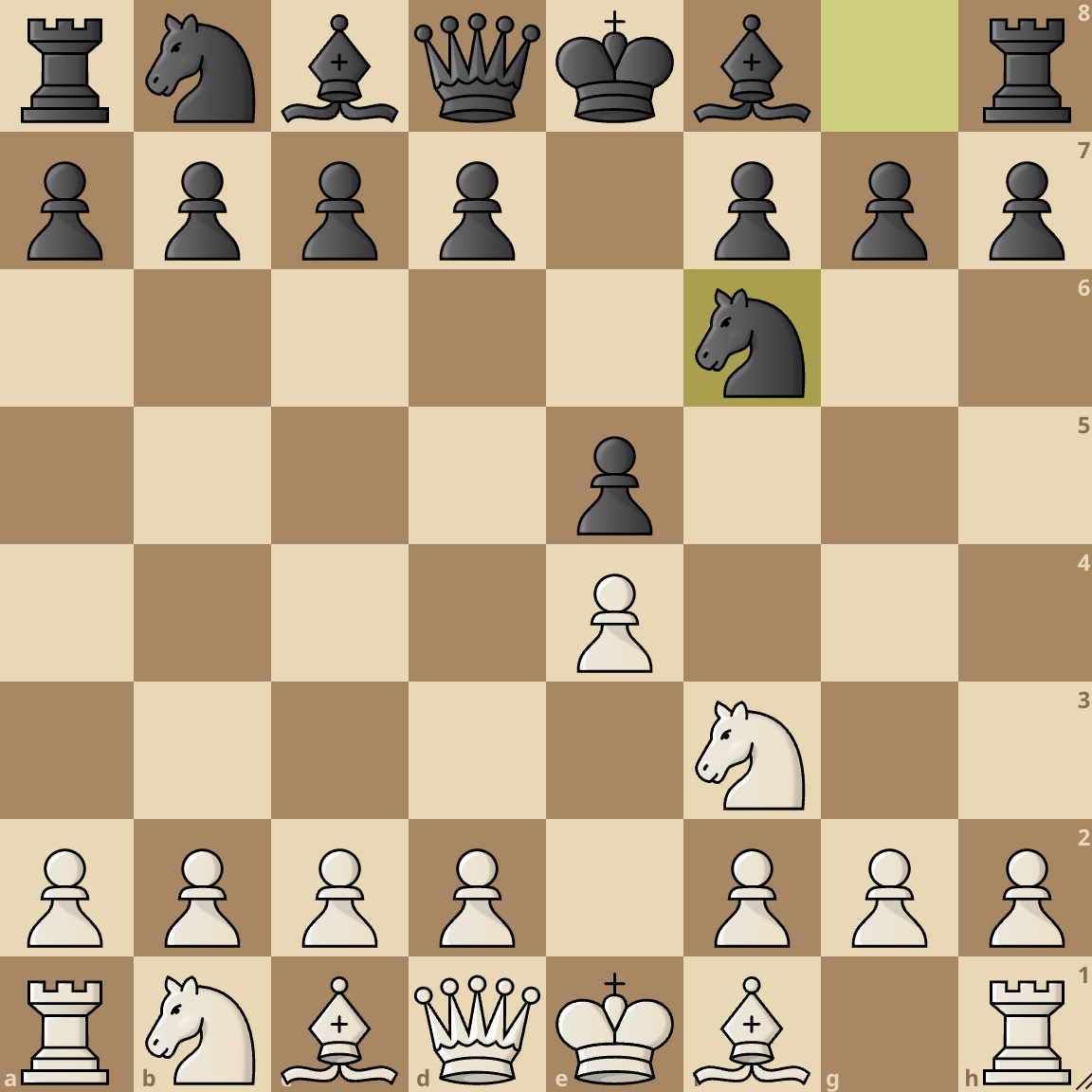
The idea behind the Petrov Defense is to immediately attack White’s e4 pawn with the Black knight, creating a counter-threat and forcing White to respond.
This opening is considered a solid defense against e4, as it somewhat neutralizes White’s advantage of having the first move.
After 3. Nxe5, Black will respond with 3…d6, attacking the knight and forcing it to retreat. White retreats with 4. Nf3 and Black then captures White’s pawn with 4…Nxe4.
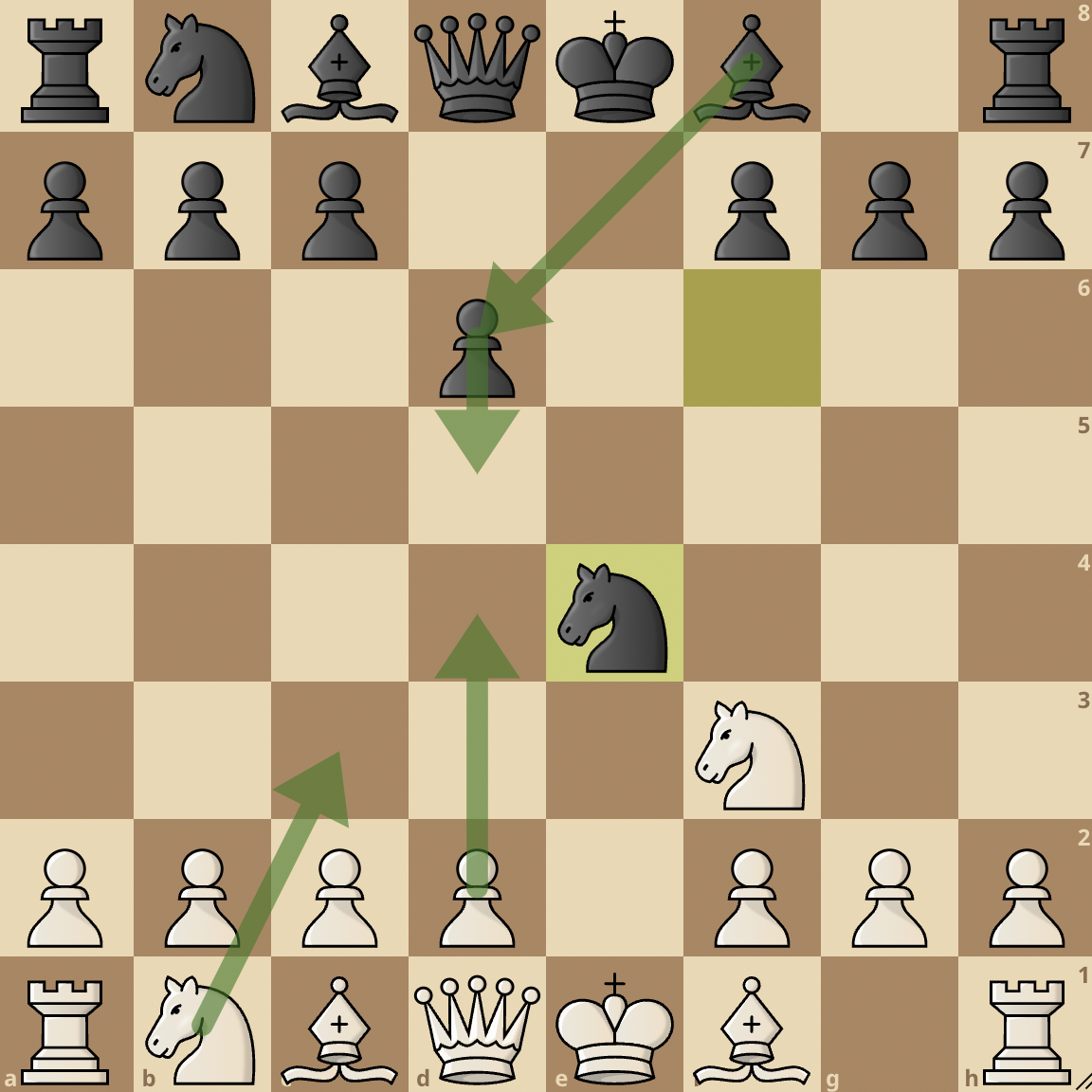
From here, White can decide to either play an open game by offering a trade with Nc3 or playing a more solid game with d4.
One of the advantages of the Petrov Defense is that it often leads to a simplified, symmetrical position in which both sides have equal chances. However, it can also lead to a slightly cramped position for Black if White plays aggressively.
Overall, the Petrov Defense is a solid and reliable opening for Black that can be used to counter White’s e4 opening. It has been played at the highest levels of chess and is a favorite of many top grandmasters.
Learn more in our detailed Petrov Defense guide.
6. Alekhine Defense
The Alekhine Defense is a hypermodern defense against the e4 pawn opening from White.
It starts with Black playing 1. Nf6 in reply to White’s 1. e4. What Black aims to do in the Alekhine Defense is to allow White to gain center control with the pawns and then try to undermine that control with their minor pieces.
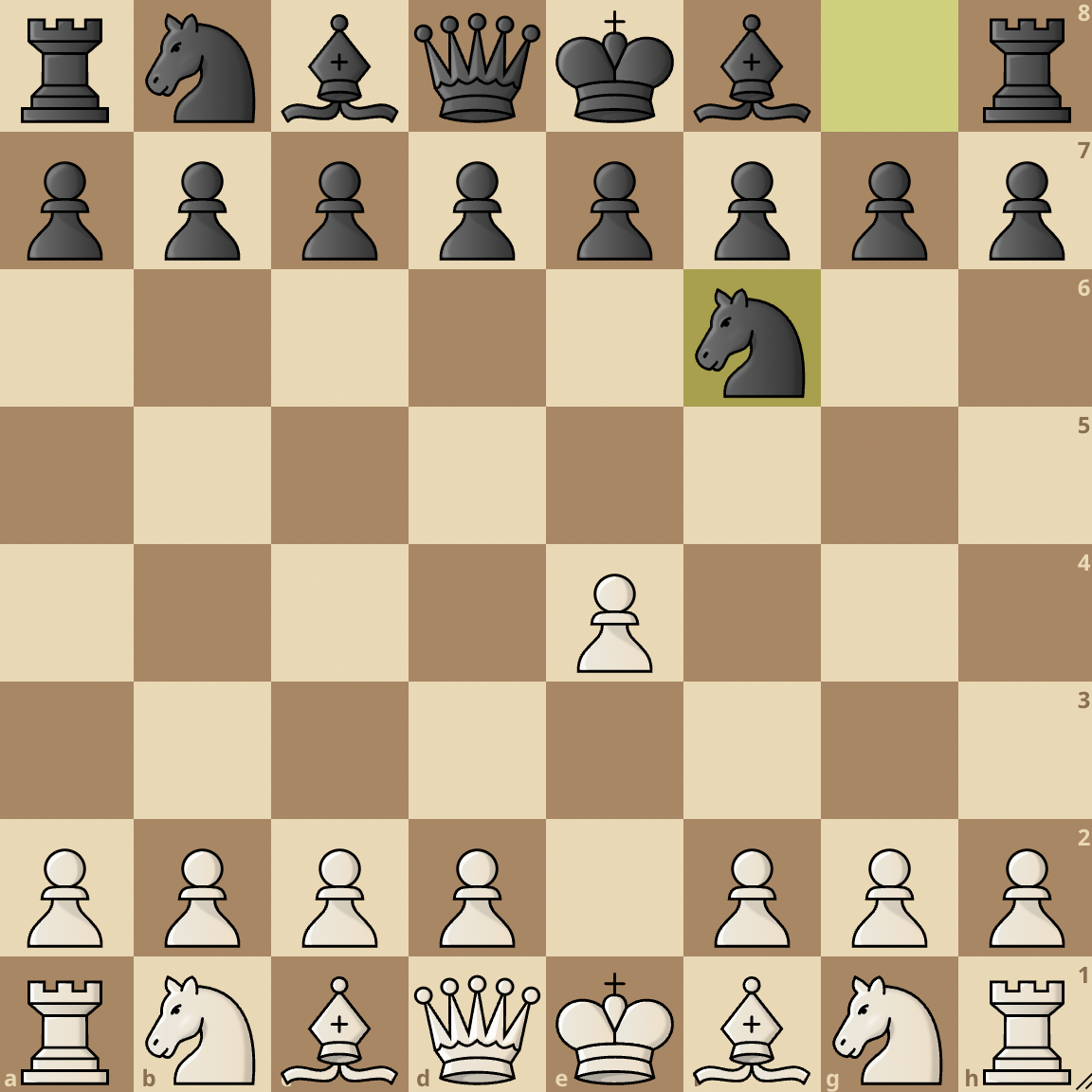
The Alekhine Defense has a few variations which include:
The Four Pawns Attack
This is the most aggressive line White can go for in the Alekhine Defense. Here White looks to control the entire center with the pawns while chasing the Black knight across the board.
The four pawns attack starts with white playing 2. e5, and black replies with 2…Nd5. White then continues with 3. d4, and black replies with 3…d6.
White continues to put pressure and impose their control of the center with 4. c4, chasing the knight further. Black replies with 4…Nb6, and white again expands center control with 5. f4 (See position below).
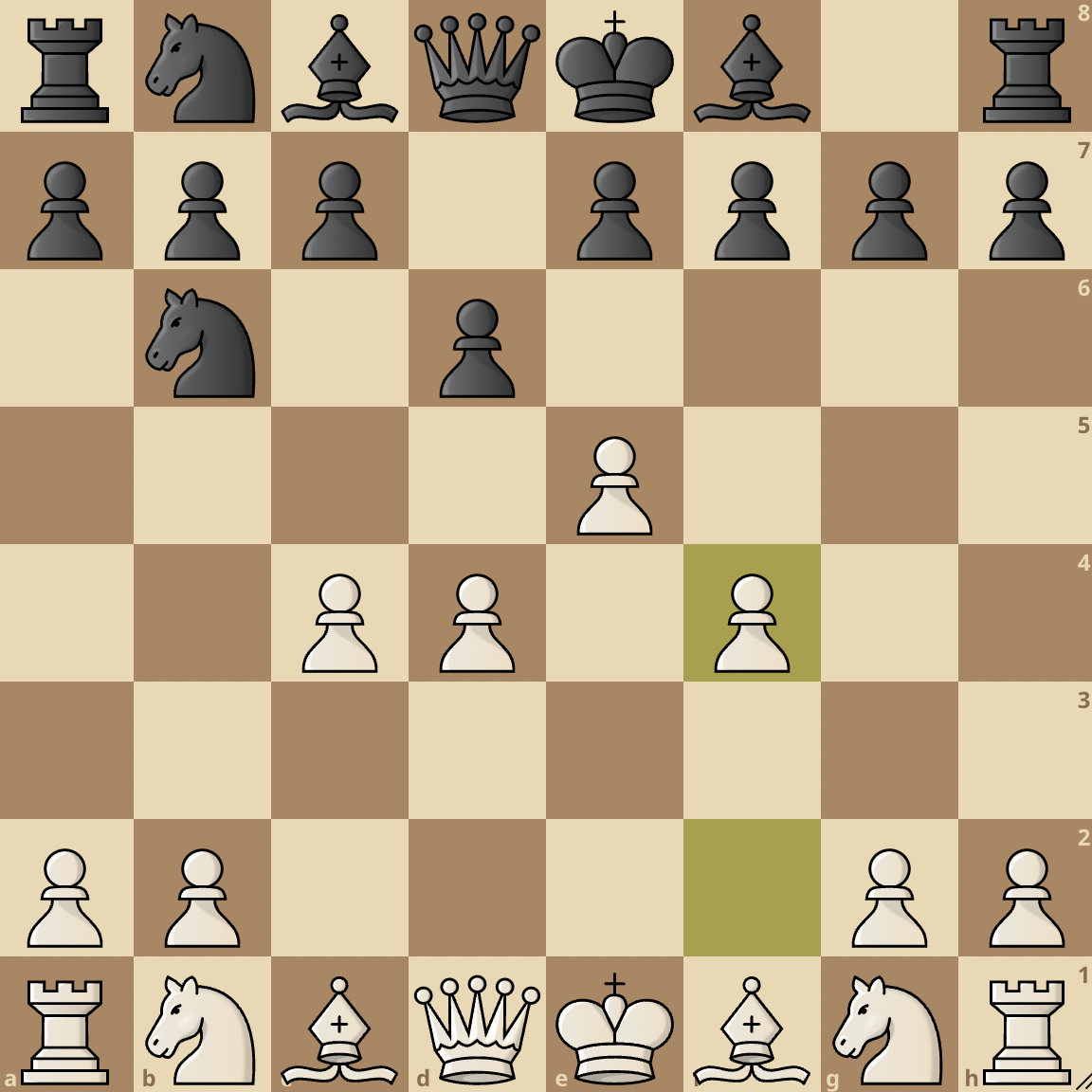
This line of the Alekhine Defense is the most aggressive one, White gains massive center control whilst Black looks for any opportunity to undermine that control.
The Exchange Variation
In this variation, after 1. e4 Nf6 is played, White plays 2. e5, and Black replies with 2…Nd5. 3. d4 is played by White and Black challenges the “e” pawn with 3…d6.
White continues with 4. c4, and Black retreats the knight to a safer square with 4…Nb6. From here, White will exchange pawns with 5. exd6.
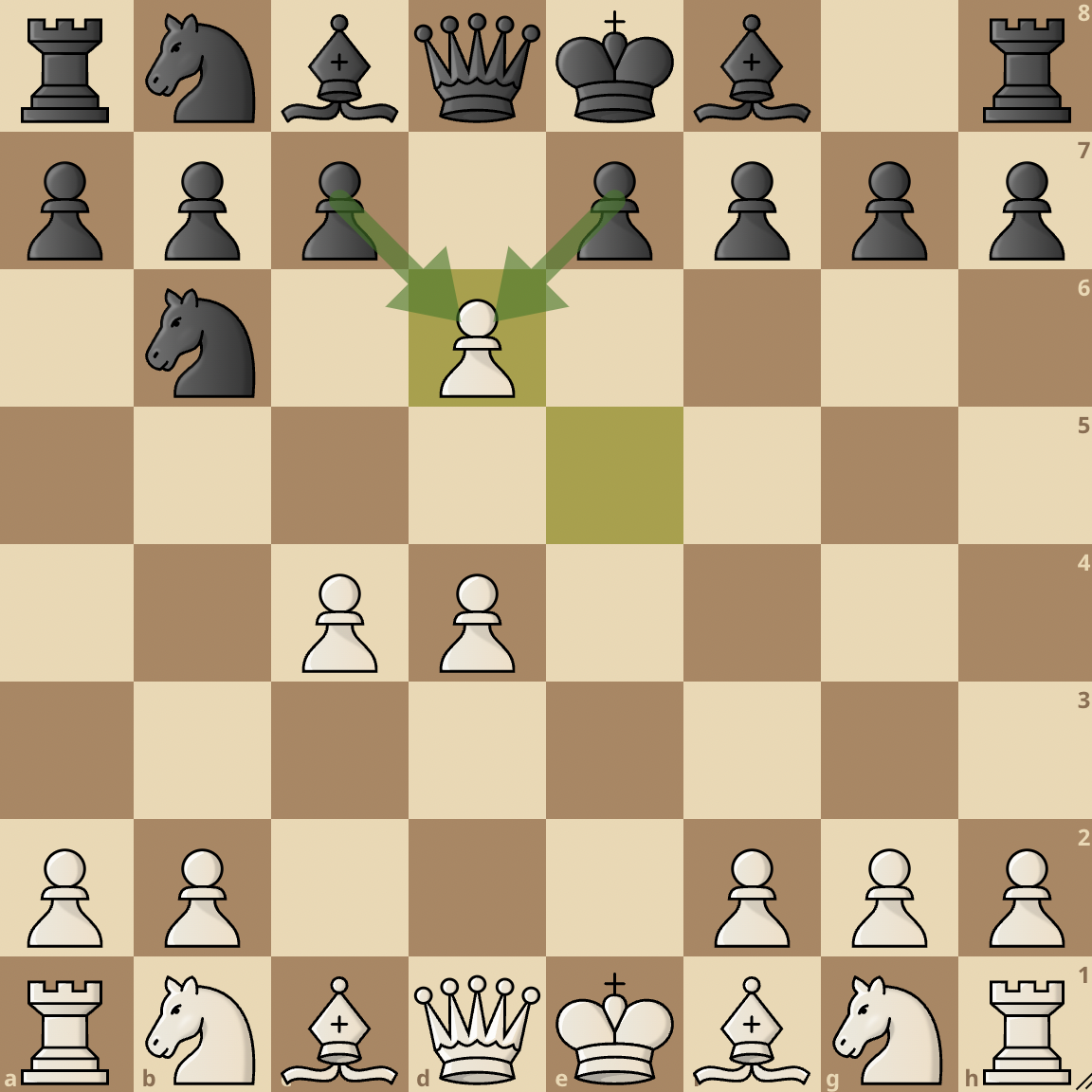
From this position above, Black can choose to either capture with the “e” pawn or the “c” pawn. Whatever way Black decides to go, this variation provides excellent tactical opportunities for both sides.
Learn more in our detailed Alekhine Defense guide.
7. Grunfeld Defense
The Grunfeld Defense is an excellent defense against the pawn opening of 1. d4 by White.
It starts with 1. d4, to which black replies 1…Nf6. White then continues with 2. c4, looking to control the center. Black replies 2…g6, getting ready to fianchetto the dark-squared bishop to the g7 square.
White then continues with 3. Nc3, developing the knight and putting pressure on the center. From here, Black plays 3. d5, and this move signifies the Grunfeld Defense.
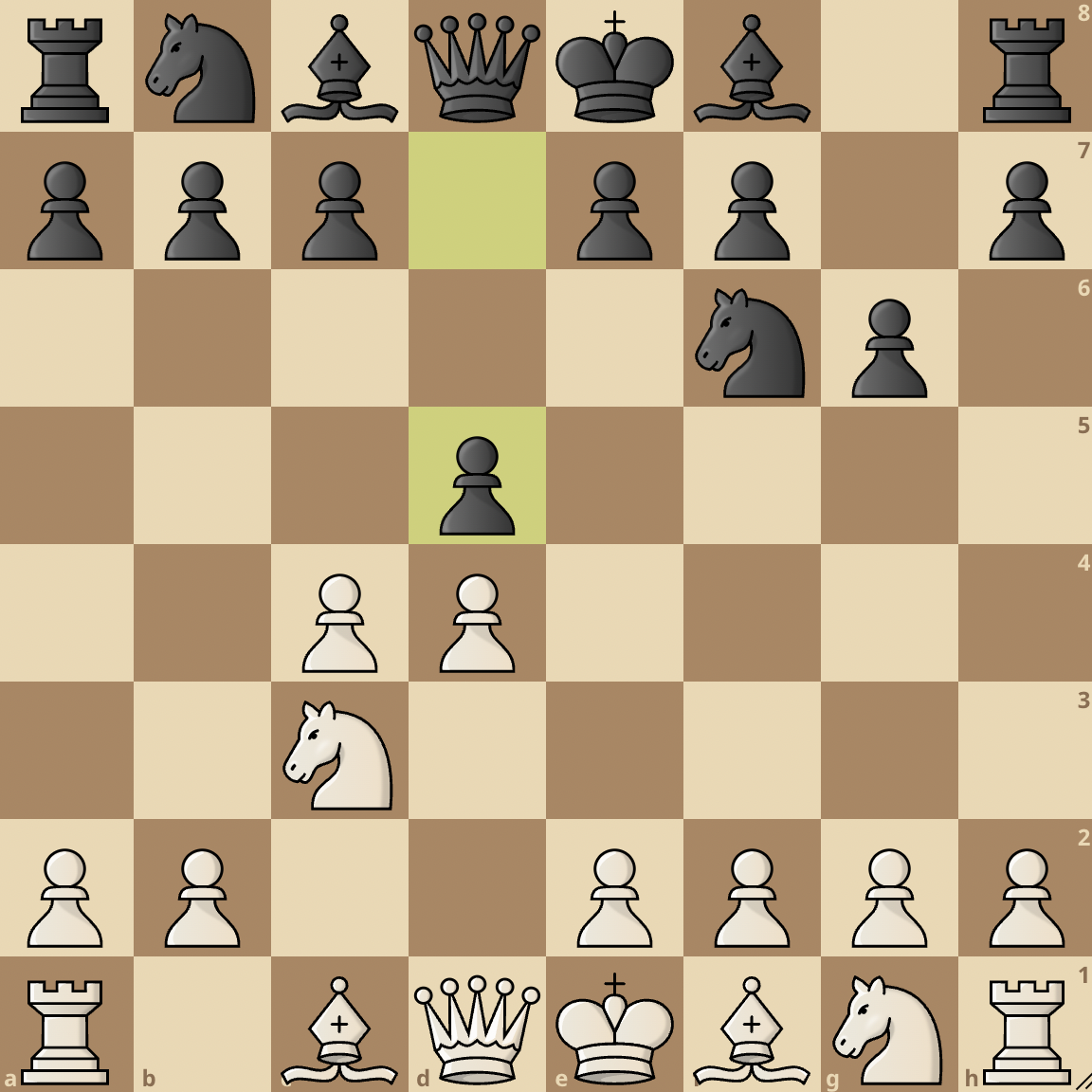
The Grunfeld Defense has a few variations, and we are going to examine some of them:
Main Line: Exchange Variation
The Main Line of the Grunfeld Defense starts with white playing 4. c×d5, to which Black replies with N×d5. White now plays 5. e4, forcing the Black knight away and gaining excellent center control.
The sequence continues with Black playing 5…N×c3 and White replies with 6. b×c3.

From this position above, the hypermodern theme of the Grunfeld Defense comes into view as Black will now play 6. Bg7, fianchettoing the bishop and looking to use the bishop’s power to undermine White’s grip on the center.
Black has other ideas such as the …c5 pawn break, Qd8-a5 attacking the c3 pawn or pinning it to the king, or …Nc6 to place pressure on the d4 pawn.
Brinckmann Attack Variation
After 3…d5 by Black, White does not have to go for the exchange variation. They can opt to play 4. Bf4. From here, Black will reply with 4. Bg7.
White then plays 5. e3, opening lines for the light squared bishop.
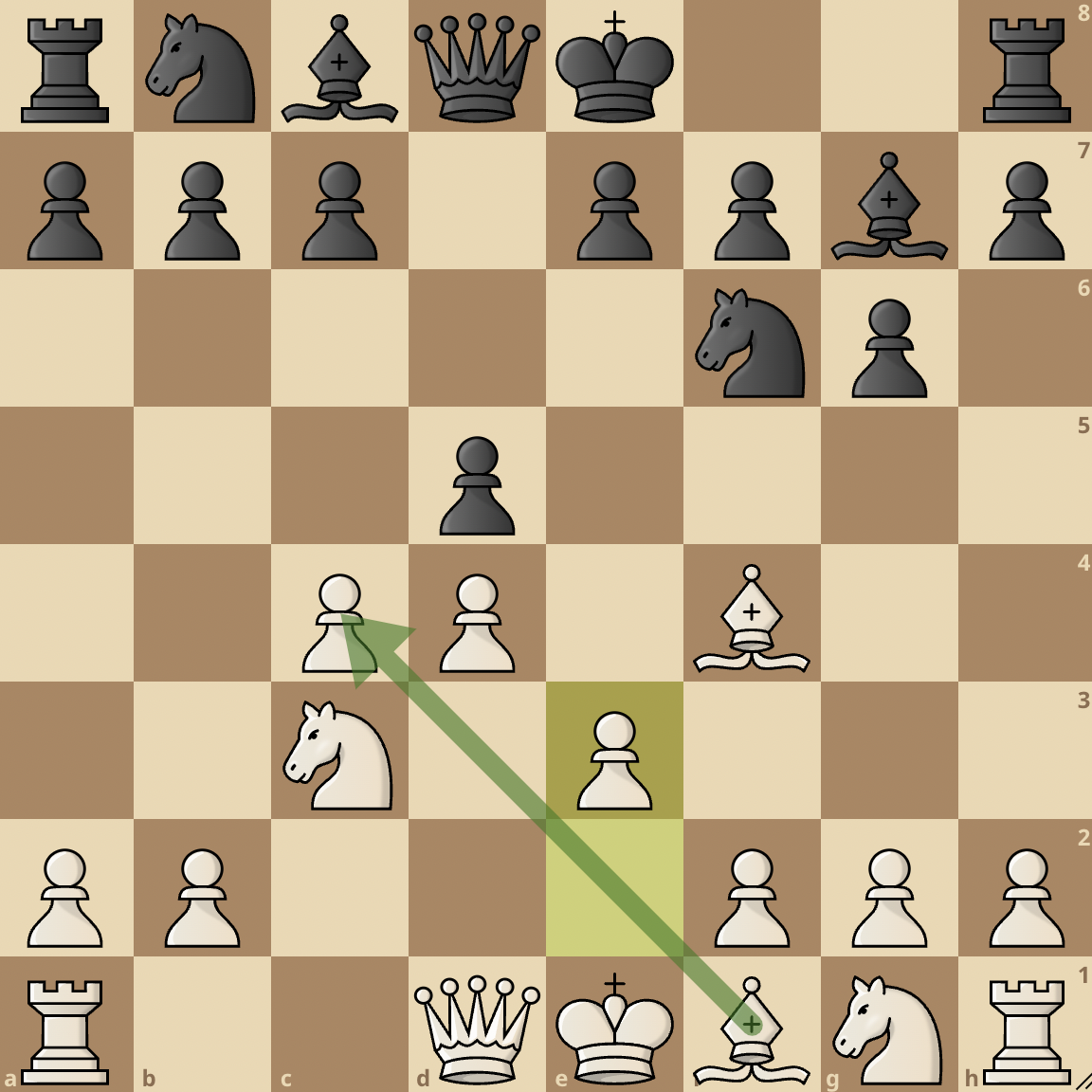
This variation ignores the idea of capturing early, unlike the exchange variation, and instead opts for the development of pieces.
Learn more in our detailed Grunfeld Defense guide.
8. French Defense
The French Defense is a very popular response to 1. e4 by White. It’s a very solid opening that is played on all levels, from amateur chess to high-level chess.
This opening starts out with 1. e4 by White, and Black responds with 1. e6. This move signifies the commencement of the French Defense.
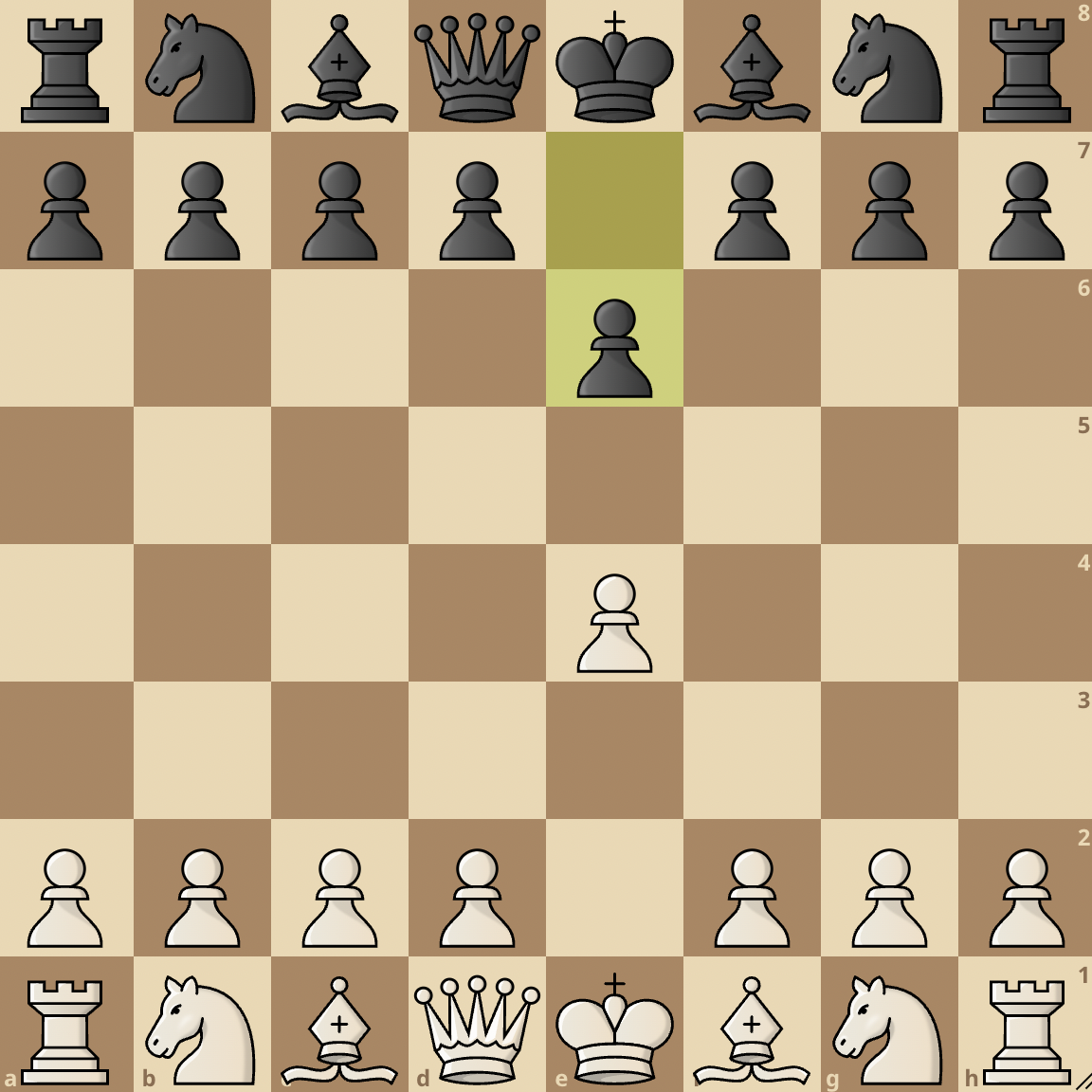
This opening has some variations, and we will examine two of them:
Advanced Variation
After 1. e4 e6, White goes on to play 2. d4, attacking the center of the board. Black then plays 2…d5.
From here, it’s clear that White wants to control the light central squares, and Black is interested in establishing their grip on the dark central squares.
The Advanced Variation continues with white playing 3. e5, choosing not to exchange in the center. From here, Black adds pressure to the d4 square with 3…c5 (see position below).
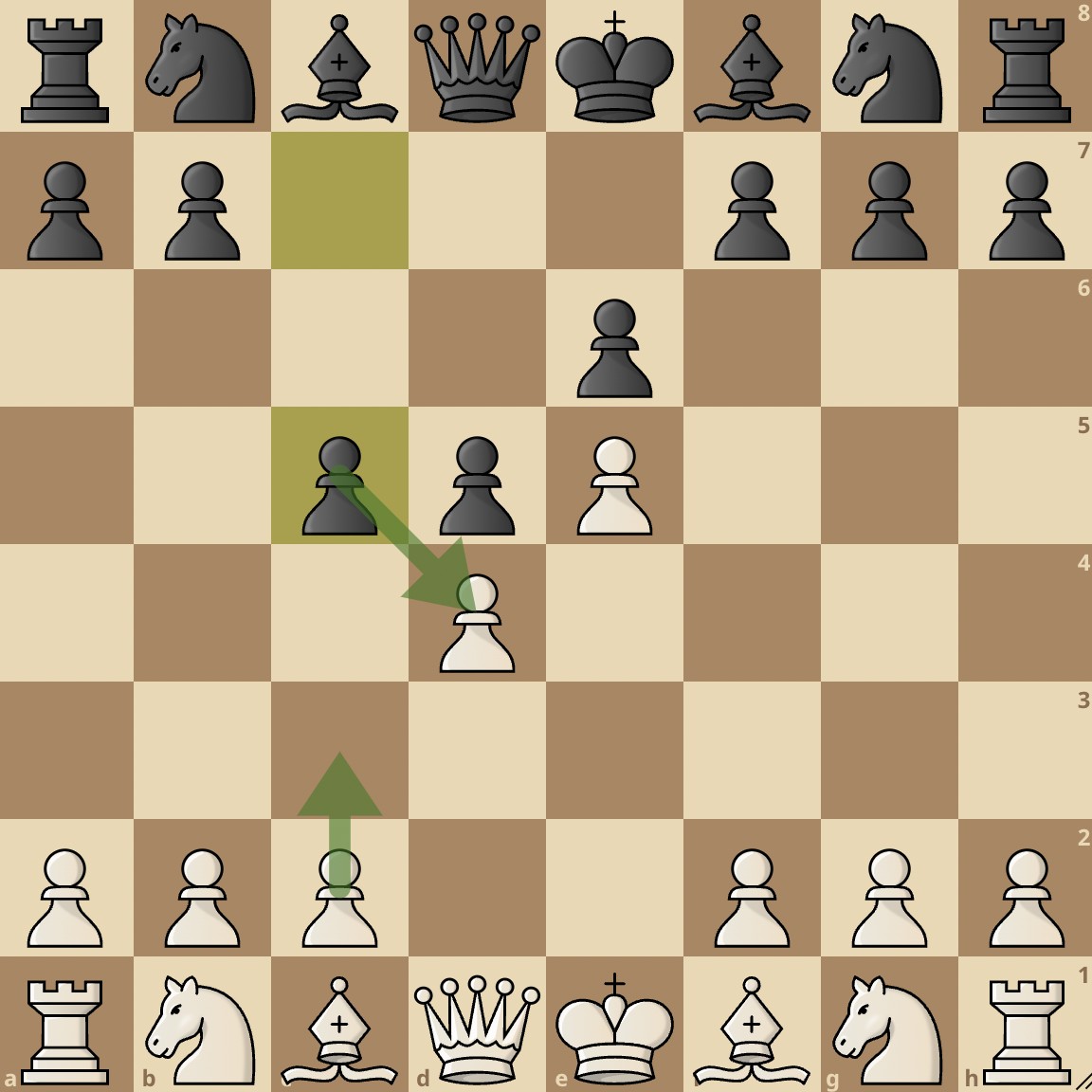
With this structure, Black challenges the over-extension of White’s “e” pawn. White has a few options they can choose from.
They might reply with c3, Nf3, or even capture with d×c5. Whatever move White decides to go for, Black will have an excellent game.
Exchange Variation
The Exchange Variation of the French Defense commences with 3. e×d5 by White. Rather than advancing the “e” pawn, White decides to trade in the center.
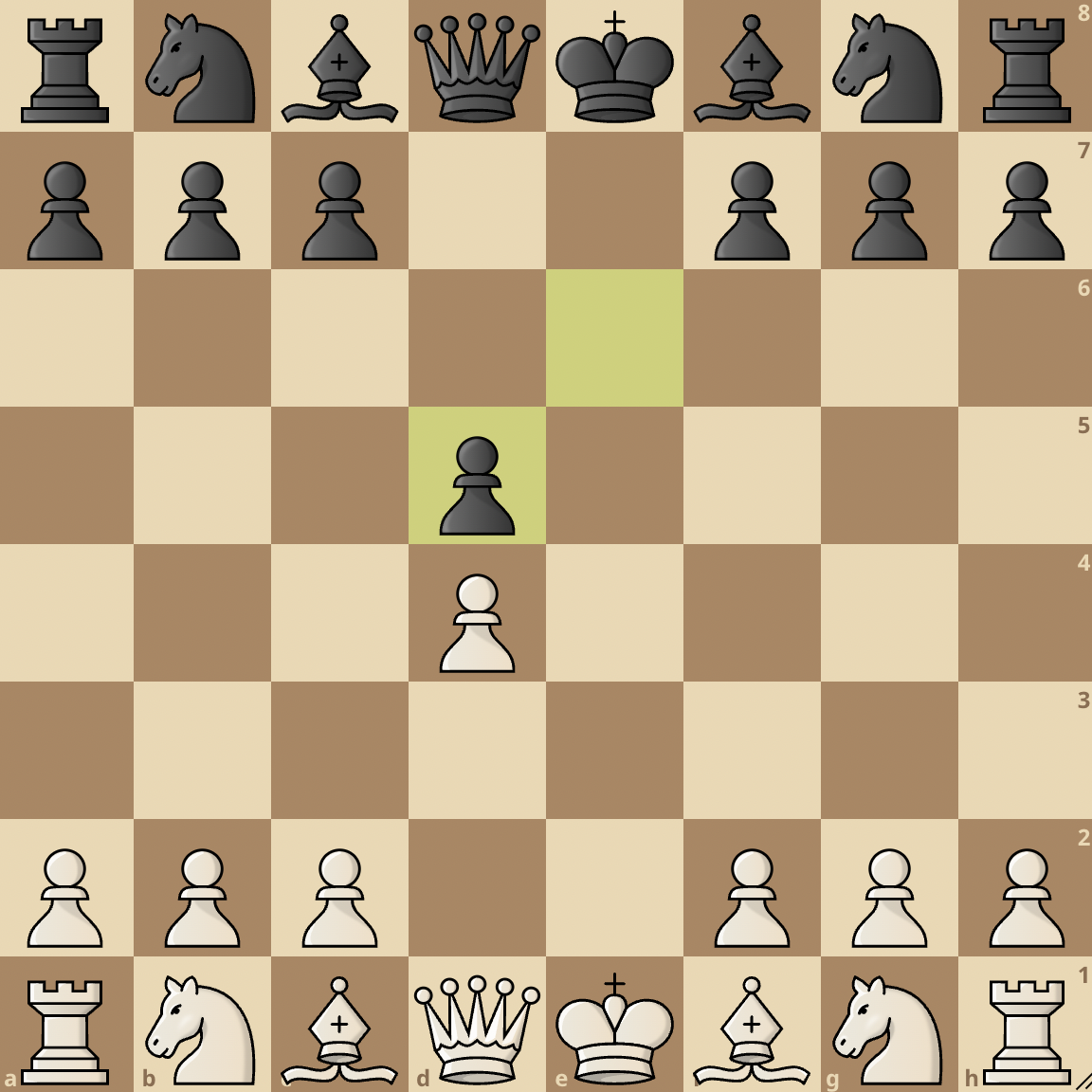
Black will capture back with 3.e×d5, and this sequence leads to an open game where both sides can freely develop their pieces.
Learn more in our detailed French Defense guide.
9. Nimzo-Indian Defense
The Nimzo-Indian Defense is a popular chess opening played by Black that arises after the moves: 1. d4 Nf6 2. c4 e6 3. Nc3 Bb4.
This opening is named after the great chess player Aron Nimzowitsch, who popularized it in the early 20th century. It’s a solid and flexible opening that allows Black to control the center of the board and develop their pieces quickly.

The move 3…Bb4 is used by Black as a pin against White’s knight on c3, which puts pressure on White’s position and prevents them from playing the move d5 to gain control of the center.
Black is willing to trade their bishop for White’s knight on c3, as this can disrupt White’s pawn structure and weaken their control of the center.
The Nimzo-Indian Defense has many variations, including the Classical Variation (4. Qc2), the Rubinstein Variation (4. e3), and the Saemisch Variation (4. f3).
Overall, the Nimzo-Indian Defense is a solid and flexible opening that can lead to a variety of positions depending on the variation being played.
Learn more in our detailed Nimzo-Indian Defense guide.
10. Berlin Defense
The Berlin Defense is a chess opening played by Black that arises after the moves: 1. e4 e5 2. Nf3 Nc6 3. Bb5 Nf6.
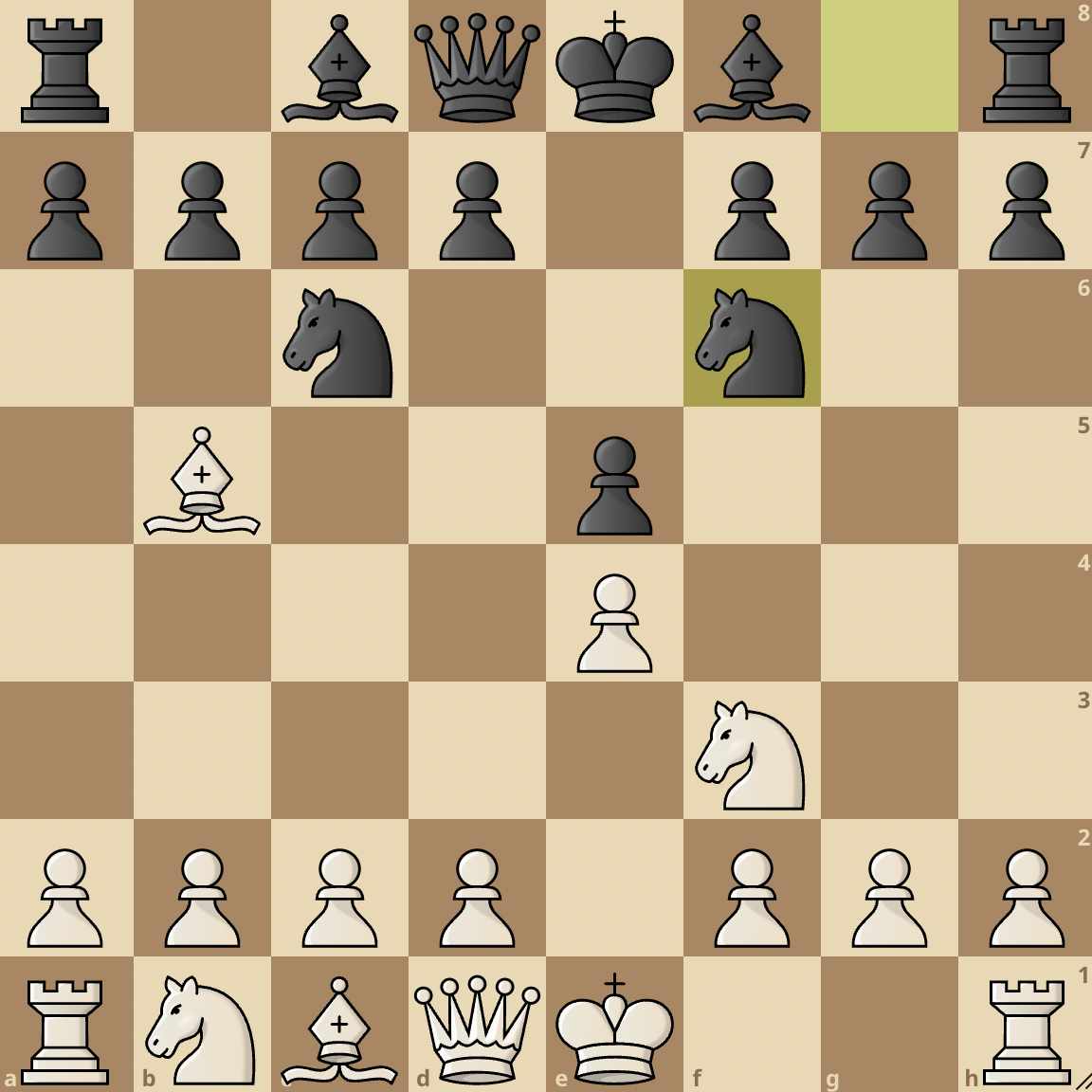
The move 3…Nf6 by Black is a counterattack against White’s pawn on e4. Black is willing to trade their knight for White’s bishop on b5, as this can help to open lines against White and quicken piece development.
One of the main advantages of the Berlin Defense is that it often leads to closed positions where both sides have solid pawn structures, making it an ideal opening for players who enjoy positional chess.
Learn more in our detailed Berlin Defense guide.
Frequently Asked Questions (FAQs)
What are some common mistakes to avoid when playing as Black in the opening?
Some common mistakes to avoid when playing as Black in the opening include neglecting development, failing to control the center, and making overly aggressive moves that expose your position. It is also important to be aware of common tactical motifs.
What is the best opening for Black in chess?
There is no single “best” opening for black, as different players have different styles and preferences. Some popular choices for blacks include the Sicilian Defense, the French Defense, and the Caro-Kann Defense.
What is a gambit in chess?
A gambit is a chess opening in which a player sacrifices material (usually a pawn) in exchange for strategic advantages, such as control of the center or the development of pieces. This article presents the top chess gambits there are out there.
What is a closed chess opening?
A closed chess opening is one in which the pawn structure creates a closed position, with limited space and fewer open lines for the pieces to move. Closed openings often involve fianchettoed bishops and slow pawn advances.
What is the purpose of a chess opening?
The purpose of a chess opening is to develop your pieces, control the center of the board, and prepare for the middlegame. A good opening can give you an advantage and set the tone for the rest of the game, while playing badly will do the exact opposite.
You may also want to check our compilation of 15 Best Chess Openings For White.






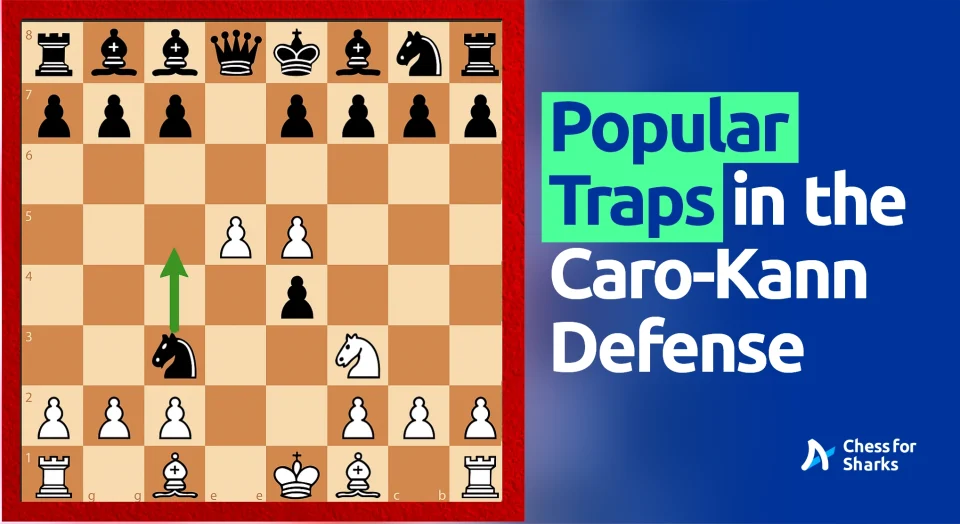
join the conversation